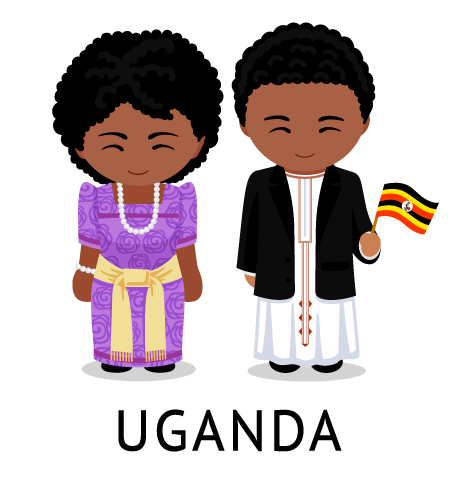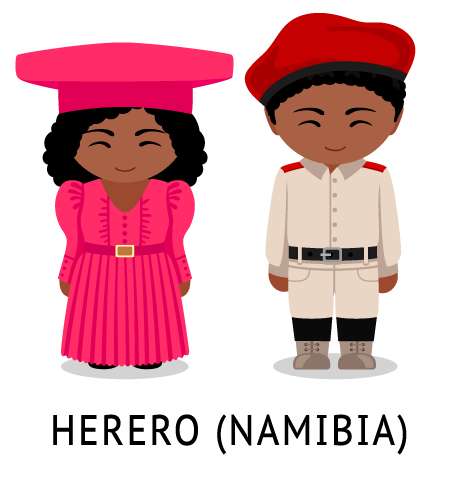
GHANA
Batakari/Fugu: An attire for both men and women in northern Ghana, crafted from cotton strips on a handloom and then either woven or sewn together, worn with a cap or hat, perceived as a sign of power and tradition as it is often worn by government authorities making public statements.
Jokoto: A traditional pant made from an African wax pattern that is universal and simple to wear, perfect for the dancehall and for getting in touch with one's roots via reggae music.
"Kaba" and "Slit": Comprises the long wrap skirt (or slit skirt) and the matching Kaba blouse (sleet).
Kaftan: A traditional clothing that may be created out of just about any material, but the most common ones are silk, wool, or cotton, usually fastened with a sash and comes in various styles for both men and women.
Ntama: A scarf or a shawl worn over the neck that is common for both men and women in Ghana

ALGERIA
Blousa: A traditional clothing worn by women in the Maghreb region, Algeria, it is a long flowing tunic, usually made of cotton or silk, with long sleeves and an open neckline, worn over a pair of loose-fitting pants or a skirt and often embellished with intricate embroidery and typically worn with a headscarf.
Deba: A traditional attire worn by people in the Maghreb region, particularly in Tunisia and Algeria, consisting of a long, wide-sleeved, loose-fitting robe worn over a pair of loose-fitting pants, often made of cotton or wool and sometimes embroidered.
Fergani: A traditional long, wide-sleeved, loose-fitting robe worn by men in the Maghreb region, particularly in Tunisia and Algeria, often made of cotton or wool and sometimes embroidered, worn over a pair of loose-fitting pants as part of traditional attire.
Haik: A veil-like garment that covers a woman from head to toe, worn with baggy pants underneath and often accompanied by a headpiece to protect the hair, reflecting Islamic influence.
Karakou: A traditional clothing worn by the Berber women of Algeria, which includes a long, embroidered velvet jacket, a matching skirt, a classic blouse, a headscarf, and a pair of traditional Berber slippers.

ETHIOPIA: HAMER TRIBE CULTURAL DRESS
Shamma: A colorful cotton wrap slung over one shoulder and wrapped twice around the body

ETHIOPIA: MURSI TRIBE
Dobi: A traditional dress garment of the Mursi males, made from a versatile fabric woven from plant fibers.

KENYA: SAMBURU
Ekori: A necklace that has beaded adornments.
Kikoi: A cloak worn by the Male Samburu around their hips.
Shuka: A multipurpose piece of cloth that may be worn around the waist and slung over one shoulder or used as a blanket or hammock, thanks to its bright red and black checkered pattern.

TANZANIA
Enkaji: A necklace that is beaded in a traditional Masai way that is an essential accessory to the community

NIGERIA
Agbada: A robe worn by Nigerian men on special occasions over their regular clothes.
Buba: A long-sleeved, loose-fitting shirt with a round or V-shaped neckline that falls at or below a woman's natural waistline; Men are not restricted from wearing the Buba.
Gele: A large, colorful headscarf used for many occasions and functions as both a beautiful head covering and a fashionable accessory; made of durable materials and worn by brides to hide their hair and ears during ceremonies while leaving their faces and jewels on display.

TUNISIA
Barnous: A traditional, long, thick wool coat with an often-large hood that is more commonly worn in the winter and resembles a poncho due to its lack of sleeves, and looks great worn atop the Jebba or any other article of apparel.
Farmla: A traditional vest adorned with exquisite gold braiding and intricate stitching, often made of luxurious velvet in colors such as pitch-black, emerald, or ruby red; the golden ornamentation stands out against the velvet, it is worn open, and the golden buttons and buttonholes are also decorated with intricate braiding.
Jebba: A traditional male attire consisting of loose-fitting shirt and slacks, often made of white silk or grey wool, and worn without any undergarments, revealing the wearer's forearms and lower legs, it is versatile and can be used in many ways like curtains, shawls, and tunics, often made of cotton or linen.
Sadria: A traditional vest with three openings for the wearer's arms and head, it only has one space, unlike the Farmla, which has both front and back openings, can be worn with a Jebba and regular slacks for a less formal everyday appearance.
Sarouel: Traditional Arabic pants, comfortable and baggy pants, designed to match with a Jebba or Sadria, often featuring pockets for small items and embroidered designs at the hem, worn with a belt made of silk or leather to hold it in place around the waist.

UGANDA
Gomesi/Busuuti: A floor-length garment is worn by both men and women in the Baganda and Basoga communities, with a square neck, triangle shoulders, a slit up one side to reveal a revealing top, and a belt cinching in the waist, worn by both men and women in these communities.
Kikoy: A longer garment with threads that trail at the bottom of the hem, which is worn over the head. It is worn as an accessory by both Gomesi and Suuti wearers.
Suuti: A three-layer soft garment worn by women of Western Uganda, especially in the regions of Banyakole, Bahima, and Batooro; comprises a wrapper skirt and a half-top, with the Batooro wearing it tucked under their arms, and the Bayakole wearing it slung over their shoulders.

NAMIBIA: HERERO
Ohorokova: An A-lined gown that has dazzling, multi-colored motifs and several petticoats
Odelela dress: A traditional dress made from odelela by the Ovambo people in Namibia worn by the women and men, decorations like beads and hides are added to it to make it beautiful
.

NAMIBIA: HIMBA TRIBE
Shamma: A colorful cotton wrap slung over one shoulder and wrapped twice around the body..

SOUTH AFRICA : REPUBLIC (ZULU)
Ibhayi: A cloak or shawl worn over one's shoulders to show respect for the in-laws
Isibamba: A thick belt crafted from dried grass and adorned with glass or plastic beads.
Isidwaba: A cowhide skirt worn by women who are married
Izincu: A long strand of twisted beads wrapped on ankles by women of childbearing age
Ureyisi: A necklace worn by women who are married.

SWAZILAND
Emahiy: They are made up of two parts: the top is an umhelwane, a large piece of fabric tied on the left shoulder, and the bottom is a sarong. The lower half comprises the lihiya, a garment worn around the waist.
Sidvwashi: A Swazi female attire that is a bottom piece.

EGYPT
Galabeya: a traditional men's and women's garment worn in Egypt, typically made from cotton or linen and characterized by its long, flowing shape and decorative embroidery.
Tarbush: a traditional men's headgear worn in Egypt and other parts of the Middle East, typically made from felt and characterized by its cylindrical shape and tassel.
Shemagh: a traditional headscarf worn by men in Egypt and other parts of the Middle East, typically made from cotton or wool and characterized by its square shape and fringes.
Jilbab: a long, loose-fitting overcoat worn by Muslim women in Egypt, typically made from lightweight, opaque fabric and covers the entire body.
Farasha: a traditional dress worn by some Egyptian women, typically made from lightweight, flowy fabric and characterized by its long, flowing shape and decorative embroidery.




